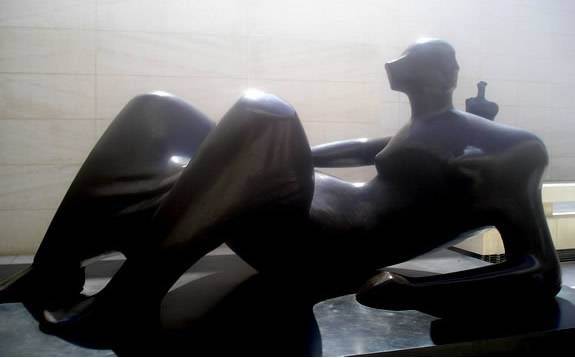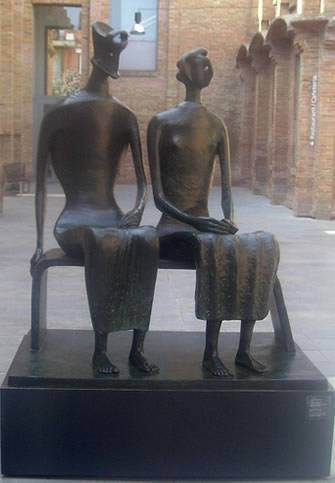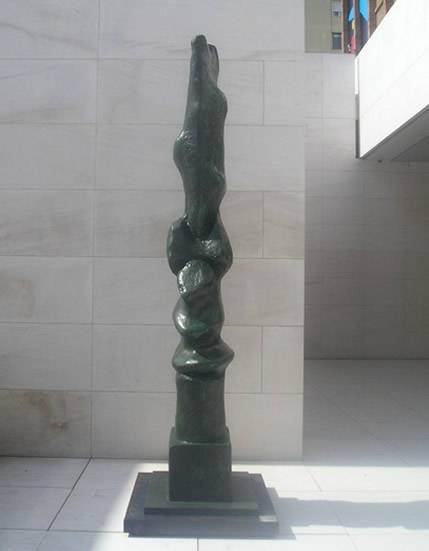Henry Moore retrospective in Barcelona
HENRY MOORE – A RETROSPECTIVE – Review of a Henry a Moore retrospective in the CaixaForum of Barcelona , September 2006
Along with Constantini Brancusi and Alberto Giacometti, Henry Moore (1898-1986) is arguably the most outstanding figure of the European sculpture of the 20th century. The son of a mining engineer, and raised in one of the most industrialized zones of Great Britain, Moore developed an exceptional mastery in working with bronze and marble, which allowed him to create a universe of forms and volumes that -from the early figuration to the late abstraction- constitutes one of the most important artistic legacies of the last century.

Henri Moore: Reclining figure, 1952-53 LH336. The Henry Moore Foundation
Henry Moore was born in Castleford, West Yorkshire (England ) in July 30th, 1898. He spent his childhood in a clearly industrialized environment, which perhaps helped him to find his early love of sculpturing forms. In fact, Moore became a sculptor when he was 11 years old, after studying the works by Michelangelo. After the World War I, in which he was injured during the Battle of Cambrai, Moore began to study in the Royal College of Art in London, where he created his first works, influenced by sculptors like Epstein, Brancusi, or even the already mentioned Michelangelo. The exhibition displays -in addition to many small sculptures, many of them with the generic name of “Composition”- several sketches that show Moore’s ability to transfer his ideas from his mind to the two dimensions, and then to the volume.
During the decade of the 1930s, Moore took part of the International Surrealist Exhibition, a movement that promoted the introduction of the surrealism in Great Britain . During this decade he began one of his most famous and recurrent compositions, his “Mother and child”, some of them present at the CaixaForum exhibition.
The World War II supposed a lapse in Henry Moore’s life and works. He momentarily stopped his sculptural investigation and produced several drawings depicting how the War was affecting his compatriots. Moore took part in the International Artists Association, a movement of leftist artists and intellectuals against Nazism and Fascism. Moore himself was affected by the Great War: his house in Hampstead received the hit of a bomb. But Moore ‘s acts against the war did not end here. In fact, the sculptor was very affected by the Spanish Civil War, to the point that the first lithograph he produced, “Spanish Prisoner”, was sold to collect funds for the Spanish republicans exiled in France . As it is logical, the Barcelona retrospective puts special emphasis in this aspect of Moore’s oeuvre.

Henri Moore: King and Queen, 1952-53 LH350
The Henry Moore Foundation
After the War, Henry Moore finally reached his artistic zenith and his international recognition, which culminated in important works like the sculpture made for the UNESCO building (1957) and another one for the University of Chicago. Several masterpieces from this period are present in the exhibition, most notably “King and Queen” (1952-53) and “Head of totem” (1968). However, the works that have given Moore international fame are his “Reclining Figures”, masterful studies of the human figure, on different scales and with different materials. Many of these “Reclining Figures”, as it happens with many other large sculptures by Moore , are conceived to be exhibited outdoors, preferably in the middle of the English landscape.
Henry Moore passed away on August 31st, 1986, and he was buried in the Artist’s Corner in the Saint Paul ‘s Cathedral in London, along with other outstanding English artists like Joseph Mallord William Turner.

Henri Moore: Vertical motif, 1955-56, LH 386
The CaixaForum exhibition constitutes an extraordinary and very complete review of the oeuvre of one of the essential sculptors of the last century. The event has also another highlight: many of the works exhibited are placed outdoors, as Henry Moore himself would wish.
Follow us on:


